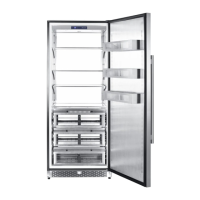What to do if my Forno FFRBI1821-30S Refrigerator does not operate?
- Jjohn27Aug 3, 2025
If your Forno Refrigerator isn't working, first ensure it's properly plugged into the wall outlet. Also, check the circuit breaker or replace any blown fuses.

What to do if my Forno FFRBI1821-30S Refrigerator does not operate?
If your Forno Refrigerator isn't working, first ensure it's properly plugged into the wall outlet. Also, check the circuit breaker or replace any blown fuses.
Why are the compartments in my Forno FFRBI1821-30S too warm?
Several factors can cause your Forno Refrigerator compartments to be too warm: * Incorrect temperature control settings: Adjust the temperature to the desired setting. * Leaving the door open or frequently opening it: Ensure the door is closed properly. * Faulty door gasket: Inspect and replace the door gasket if necessary. * Recently storing a large amount of warm or hot food: Allow the refrigerator time to reach its selected temperature. * Recent disconnection: Allow time for the refrigerator to cool properly after reconnection.
How to prevent moisture from collecting inside my Forno FFRBI1821-30S Refrigerator?
To prevent moisture inside your Forno Refrigerator, ensure the door is closed properly, avoiding it being left open or frequently opened.
How to stop my Forno FFRBI1821-30S from vibrating or rattling?
To stop your Forno Refrigerator from vibrating or rattling: 1. Adjust the leveling legs to stabilize the refrigerator. 2. Move the refrigerator to a more stable surface. 3. Re-level the refrigerator and move it away from the wall, ensuring it's not touching.
Why does moisture form on the outside of my Forno Refrigerator?
Moisture forming on the outside of your Forno Refrigerator is normal in hot and humid weather. Air carries moisture into the refrigerator when doors are opened.
What causes popping or cracking sounds in my Forno FFRBI1821-30S Refrigerator when the compressor comes on?
Popping or cracking sounds when the compressor comes on in your Forno Refrigerator are normal. Metal parts undergo expansion and contraction, similar to hot water pipes.
| Brand | Forno |
|---|---|
| Model | FFRBI1821-30S |
| Category | Refrigerator |
| Total Capacity | 18.2 cu. ft. |
| Door Style | French Door |
| Color | Stainless Steel |
| Ice Maker | Yes |
| Capacity | 18.2 cu. ft. |
| Frequency | 60 Hz |
| Shelves | Glass |
| Door Shelves | Yes |
| Crisper | Yes |
Details for contacting customer service regarding model, serial, and purchase date.
Contact information and support details for customers in Canada.
Contact information and support details for customers in the United States.
Precautions to prevent child entrapment and suffocation in discarded appliances.
Guidelines on handling, placement, electrical safety, and preventing fire/explosion hazards.
Requirements for safe installation, including two-person lift, ventilation, and electrical connections.
Steps to take before initial operation, including cleaning and placement considerations.
Guidance on selecting a suitable location and preparing the installation site for the appliance.
Instructions for securely installing the anti-tip bracket to prevent appliance tipping.
Recommendations for optimal placement, clearance, and ambient temperature for efficient operation.
Essential guidelines for connecting the refrigerator to a safe and properly grounded electrical outlet.
Identification of various parts and features of the refrigerator with a visual diagram.
Key dimensions and weight information for the built-in refrigerator model.
Procedure for adjusting the appliance's leveling legs to ensure stability and proper operation.
Step-by-step guide for attaching the refrigerator door handle securely.
Instructions on how to operate the temperature settings and power on/off the unit.
Information about the internal LED light and its operation when the door is opened.
Explanation of the automatic defrost system and manual defrosting procedures if needed.
Detailed steps for reversing the door opening direction for user convenience.
Guidelines for cleaning the interior and exterior of the refrigerator for optimal hygiene and performance.
Recommendations for protecting food contents during power outages and after restoration.
Instructions on how to prepare the refrigerator for short and long periods of absence.
Steps to follow when moving the appliance, including securing contents and doors.
Advice on locating and operating the refrigerator to maximize energy efficiency.
Identification and solutions for frequently encountered problems like non-operation or temperature issues.
Troubleshooting steps for noises, door closing problems, and other minor operational faults.
Critical safety warnings covering ventilation, defrosting, refrigerant circuits, and electrical appliances.
Guidance on safe disposal and recycling, and warnings for individuals with limited capabilities.
A visual representation of the refrigerator's electrical circuit for technical reference.
